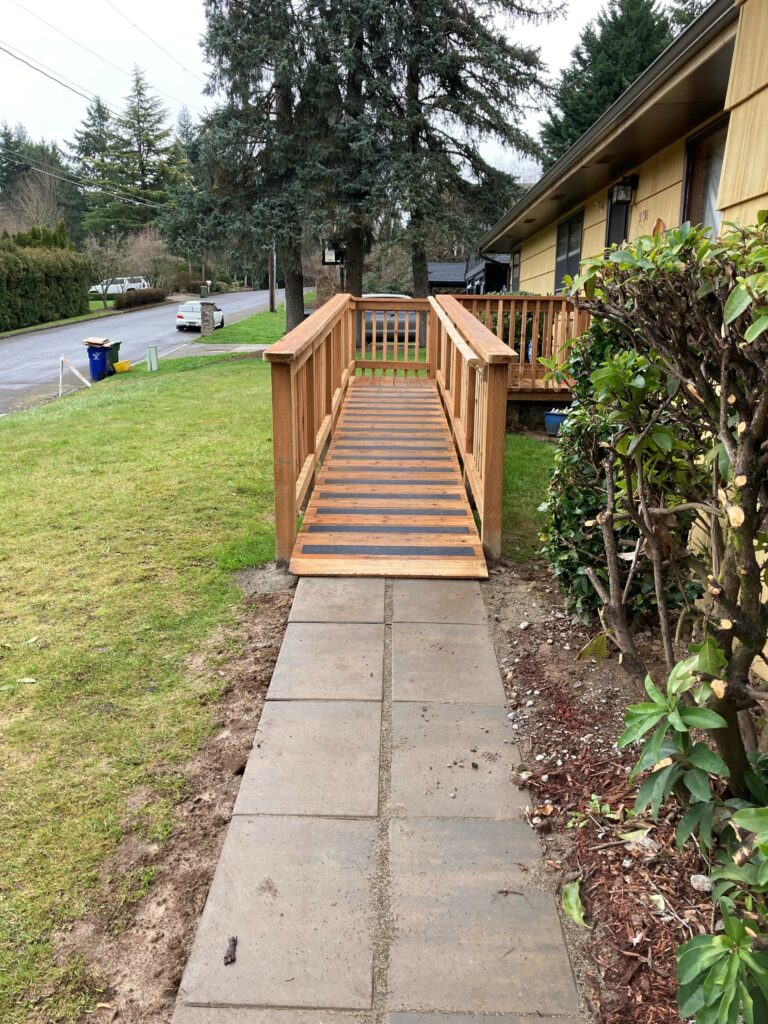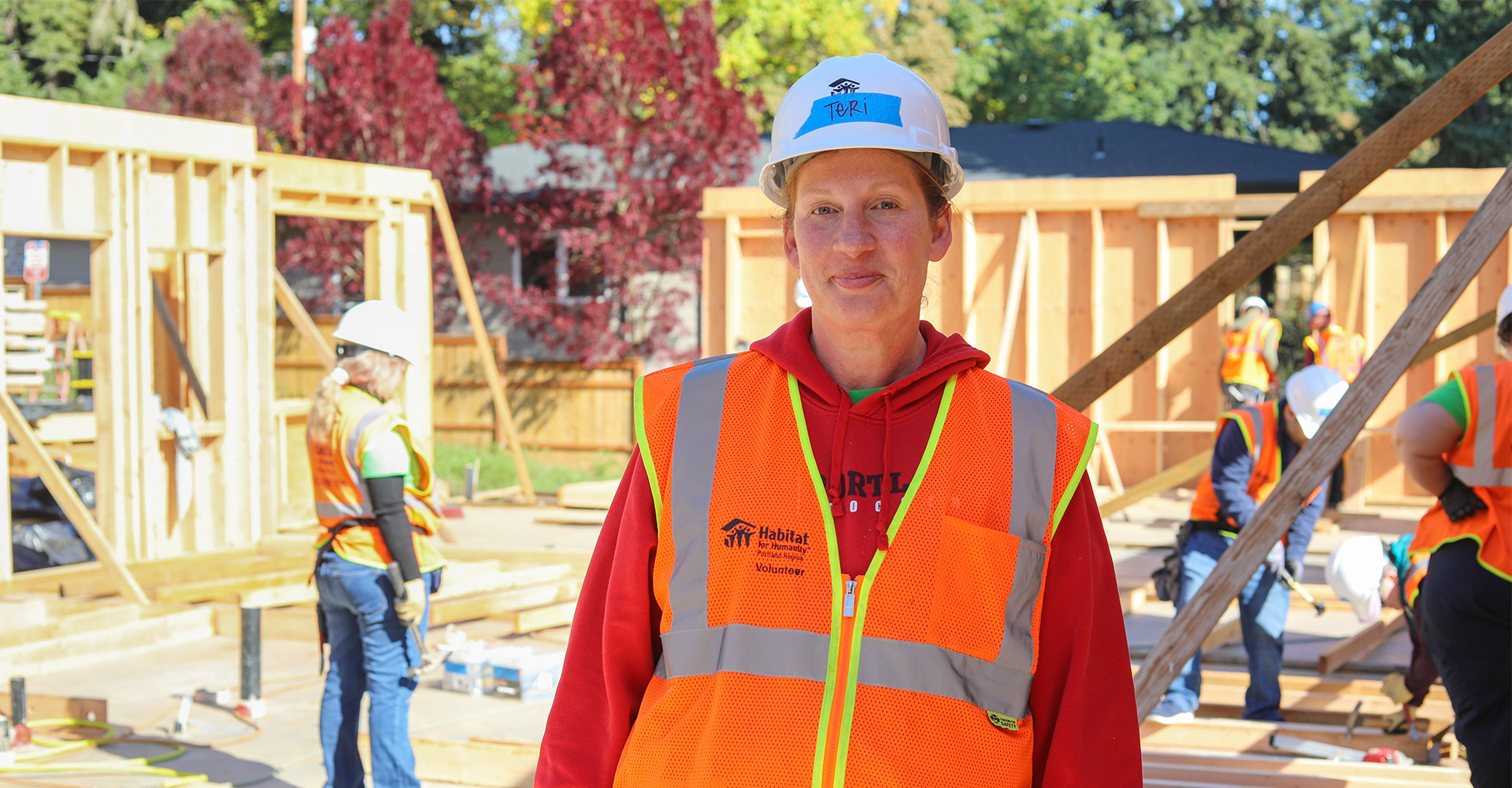
What makes a house a home?
To answer that question, you might ask Anna Bowlby, who has lived in her Portland home for 65 years. Her family moved in when she was 6 years old, and it was there that she and her four siblings created the childhood memories she remembers to this day.
As an adult, Anna moved out of the house for a short while, but returned to be with her mother, Evelyn, after her father passed away. She stayed with her mother in their home until Evelyn passed away in 2023 at the age of 92.
“This home is very important to me,” Anna said. “I’ve shared all my happiest times here.”
Many people feel the same as Anna about their home. According to AARP, 77% of adults over the age of 50 want to remain in their homes as they age. But as our population ages, many homes are not prepared to meet the needs for accessibility features like zero-step entries, accessible kitchens and bathrooms, and features that allow first floor living and adaptable features as people age in place.
As Anna’s mother aged, her home became progressively less suitable for her increasing physical needs. She had been sick for a couple of years, suffering from congestive heart failure, COVID-19, and even a stroke during the pandemic. Once she was confined to a wheelchair, Anna began to struggle with getting her mother in and out of the house. It was not easy navigating the steep steps and driveway to the front door.
It was Anna’s doctor who referred her to Habitat’s Home Repair Program.
“I did not have a way to get her out of here in case of an emergency,” she said. “It started to really worry me.”
In 2022, Habitat installed a wheelchair ramp so Anna could get her mother in and out of the house with ease. The project took about a week to complete, and Habitat made sure Anna had a way to get down the stairs while the work was going on.


Sadly, Evelyn passed away shortly after the ramp was completed. But Habitat’s work was there for Anna. Soon after her mother died, Anna suffered a fall that broke her pelvis and five ribs. She could hardly walk.
For Anna, the ramp was not only a way to get in and out of her home, but also a physical therapy device. The angle of the ramp was perfect for practicing walking forwards, backwards, and sideways. Anna remembers walking that ramp 50 times a day as it helped her heal, waving at her neighbors all the while. She is now progressing from using a walker to a cane.
“We didn’t have a lot growing up, and so to be able to stay here for a little longer would mean so much to me,” Anna said. “But I wouldn’t be able to stay here if I didn’t have things in place, like the ramp, to be able to do that.”
Habitat’s Home Repair Program
Anna’s ramp is just one of the many home repair projects Habitat has undertaken to improve the lives of Portland homeowners. Home Repair Manager Anthony Grimaldi said that while most of their projects are wheelchair ramps and roof replacements, Habitat does a variety of improvements that help older and disabled people stay in their homes, including fixing loose carpet, installing slip-resistant flooring, adding hand railing down hallways, and adjusting toilet heights.
Habitat’s home repair program helps households with low incomes alleviate health and safety issues by completing critical home repair projects, specifically for those who are aging or disabled.
“Aging in place is preventing displacement,” Anthony said. “Most people want to stay in their homes and not go into an assisted living facility that costs more than people can afford.”
None of us are getting any younger: The Portland senior population (65+) increased from 11% in 2015 to 13% percent in 2020. Homes are also aging along with the population.
About 4 million US households with an adult over 65 have difficulty living in or using some features of their home, according to a recent report by the US Census Bureau. Only 40% of homes have the most basic, aging-ready features — a step-free entryway into the home and a bedroom and full bathroom on the first floor.
It’s not uncommon for people on limited incomes to delay needed repairs because of the cost, which can lead to problems later that become too expensive to handle. As people and their homes continue to age, the safety of existing homes takes on an increasingly important role in the housing market.
Many of the clients Habitat’s home repair serves are seniors who live alone. When you live alone, Anthony said, there is a higher risk of falling with nobody there to support you. Habitat’s home repair program assesses how homes can be improved to prevent falls and create a safer environment.
Sometimes the solution isn’t obvious to the homeowner. After living in the same home for several years, people become accustomed to the way it is, Anthony said, even if the layout is no longer as safe for them as it was.
“In the grand scheme of things, aging in place and fall prevention improvements tend to be smaller scale projects that really go a long way,” Anthony said.
Local efforts
In 2021, the Oregon Legislature enacted legislation that helps achieve “Healthy Homes” for low-income households and communities impacted by environmental justice factors.
The grant program assists with radon and lead exposure, excessive heat, poor indoor air quality, and general safety in homes. While this type of program is a step in the right direction for ensuring that more folks can age in place, there is still more comprehensive work to be done.
Alan DeLaTorre, adjunct professor at Portland State University and the former age-friendly city program manager for the City of Portland, recently published a report advocating for creating age-friendly centers, increasing accessible public spaces, and providing more support for people who want to age in place.
The Age and Disability Inclusive Neighborhoods Action Plan is a roadmap to address these issues.
Services are often hard to obtain for those with mobility issues or those who live alone. Neighborhoods without sidewalks and a lack of access to public transportation make life difficult for those who wish to remain in place as they age.
To combat this issue, cities could build more “complete neighborhoods,” also known as “15-minute neighborhoods.”
A complete neighborhood is an urban area that is designed to be accessible to transit services, government offices, grocery stores, or anything else someone might need to get to within 15 minutes without needing to make multiple trips in a car.
Cottage clusters are another way for the city to provide an opportunity for people to age in place within a socially connected community. These spaces are made up of accessible and affordable smaller homes where people of all ages lean on each other for social connection.
“Our social circles tend to shrink as we age; people die and people move away,” Alan said. “Older adults in particular have to address issues of loneliness in a different way.”
It is impossible to plan for the future without addressing climate change. The heat waves in recent years elevated the issue of vulnerability for older adults. Installing heating and air conditioning units in the homes of aging and disabled populations is more important now than ever.
However, Alan said that there are crucial voices missing in the climate action planning movement: those of older adults. Climate change is often thought of as a young person’s movement, he said, and the ideas of older adults are often left out of the discussion.
“There’s a lot of (Baby) Boomers and older adults in general who are very committed to and excited about climate justice, but they have not been at the table,” Alan said. “There’s an opportunity for the city to get over some of the ageism that exists and try to bring together the frontline communities of color, youth, and older adults who want to be good stewards of the future.”
Habitat Portland Region completed 40 home repair projects this fiscal year and is planning to do more home repair projects in the coming year.
To learn more about the Home Repair Program, visit our home repair section or write to sam.eckhart@habitatportlandregion.org.


